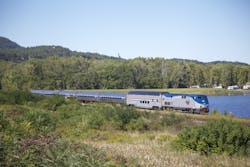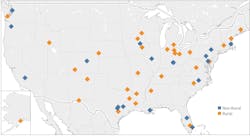CRISI grants to improve infrastructure and safety of nine passenger rail projects
The Federal Railroad Administration (FRA) released the list of 50 projects in 29 states to be awarded a total of $320.6 million through the Consolidated Rail Infrastructure and Safety Improvements (CRISI) Program.
“This $320.6-million federal investment will upgrade U.S. rail infrastructure and enhance rail safety in communities across America,” said U.S. Transportation Secretary Elaine L. Chao.
Nine projects in as many states were awarded more than $101 million to complete projects that will benefit passenger train movements.
“We remain committed to helping address pressing transportation capital needs, particularly in rural areas,” said FRA Administrator Ronald L. Batory. “I am pleased that so many high-quality applications were submitted for worthwhile investments by the FRA.”
A full list of passenger rail related projects to secure CRISI grants is as follows:
Alaska – M.P. 25.7 Trail River Bridge Replacement Up to $4,110,480 for Alaska Railroad Corporation: Replaces a timber railroad bridge over the Trail River, approximately 23 miles north of Seward. The new bridge will support the Alaska Railroad Corporation’s freight and passenger rail services and operations by allowing industry standard gross weight capabilities of 286,000-pound railcars and intermodal double-stack cars.
New Mexico – SW Chief Raton Route Modernization Program (Opportunity Zone) Up to $5,629,610 for National Railroad Passenger Corporation (Amtrak): Improves Amtrak’s Southwest Chief between Trinidad, Colo., and control point (CP) Madrid in New Mexico, located between Lamy and Albuquerque. Specifically, the project converts approximately 12.4 miles of bolted rail to welded rail between Lamy and CP Madrid; installs approximately 14,750 new crossties; rebuilds the timber decks of two railroad bridges; and performs rock scaling at several locations.
Wisconsin – Twin Cities-Milwaukee-Chicago Intercity Passenger Rail Service Project (Qualified Opportunity Zone) Up to $31,800,000 for Wisconsin Department of Transportation: Funds six infrastructure improvements in Wisconsin and Minnesota on Canadian Pacific-owned track to add the first state-supported intercity passenger rail frequency between the Twin Cities and Milwaukee to contribute to an eighth round-trip on the Hiawatha service between Milwaukee and Chicago. The Twin Cities are currently only served by Amtrak’s long-distance Empire Builder route. The project includes upgrades to communication and signaling, extends rail sidings, improves at grade crossings, extends yard lead track and reconstructs and modifies new turnouts and mainline track.
North Carolina – Southeast Corridor Acquisition Project (Multiple Opportunity Zones) Up to $47,551,484 for North Carolina Department of Transportation: Purchases right-of-way along CSX’s S-Line rail corridor from Raleigh to Ridgeway to preserve the corridor for future intercity passenger rail service.
Colorado – Front Range Passenger Rail Preliminary Service Development Plan and Railroad Simulation Modeling Study (Multiple Opportunity Zones) Up to $548,000 for the city of Trinidad: Completes an alternatives analysis and service planning analyses for a future 180-mile intercity passenger rail corridor between Pueblo and Fort Collins.
Maryland – Martin's Yard Northeast Corridor Switch Modernization Project (Opportunity Zone) Up to $3,100,000 for the Maryland Transit Administration: Funds the replacement of a hand-thrown turnout with a power-operated turnout where MARC Commuter trains enter and exit Martin Yard on the Northeast Corridor (NEC) in Middle River. The project removes a safety risk for MARC workers, increases intercity passenger rail capacity at Baltimore Penn Station by reducing MARC storage there and improves the fluidity of the NEC in Maryland north of Baltimore.
Massachusetts – City of Chelsea Quiet Zone (Multiple Opportunity Zones) Up to $1,130,000 for the city of Chelsea: Installs four-quadrant gates, grade-crossing warning signage and upgrades pavement markings at six railroad crossings along a 1.47-mile corridor on the MBTA’s East Route Main Line in Chelsea which sees close to 70 freight and passenger trains per day.
Oregon – Brooklyn Subdivision Rail Corridor Improvement Project (Multiple Opportunity Zones) Up to $3,691,900 for the Oregon Department of Transportation: Rehabilitates an inactive one-mile-long siding along Union Pacific’s single-track mainline on the Pacific Northwest Rail Corridor between Portland and Salem to allow for more efficient operation of freight and Amtrak trains.
Washington – Pacific Northwest Rail Corridor Reliability - Landslide Mitigation Phase III Up to $3,719,000 for Washington Department of Transportation: Constructs landslide catchment walls along approximately one mile of track at Milepost 25 on the Pacific Northwest Rail Corridor between Seattle, Wash., and Portland, Ore. This project is Phase 3 of a Landslide Mitigation Plan, identifying short-, intermediate- and long-term activities needed to reduce rail closures due to landslides. During the past 10 years, this area has seen 24 landslides and passengers have been diverted to other forms of transportation 940 times.
About the Author

Mischa Wanek-Libman
Group Editorial Director
Mischa Wanek-Libman is director of communications with Transdev North America. She has more than 20 years of experience working in the transportation industry covering construction projects, engineering challenges, transit and rail operations and best practices.
Wanek-Libman has held top editorial positions at freight rail and public transportation business-to-business publications including as editor-in-chief and editorial director of Mass Transit from 2018-2024. She has been recognized for editorial excellence through her individual work, as well as for collaborative content.
She is an active member of the American Public Transportation Association's Marketing and Communications Committee and served 14 years as a Board Observer on the National Railroad Construction and Maintenance Association (NRC) Board of Directors.
She is a graduate of Drake University in Des Moines, Iowa, where she earned a Bachelor of Arts degree in Journalism and Mass Communication.

